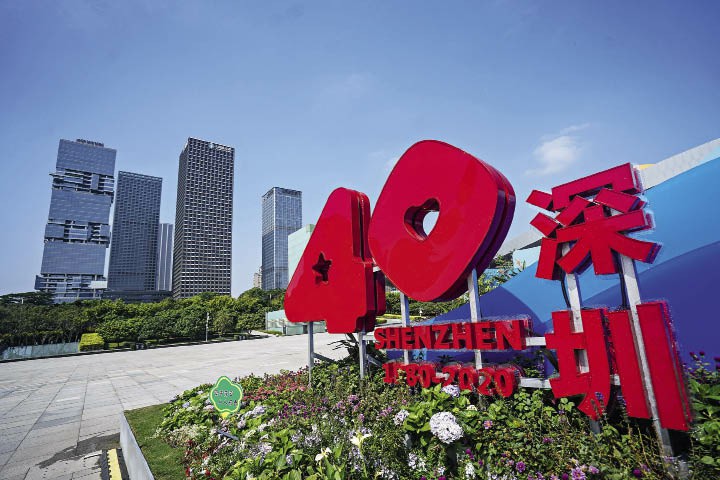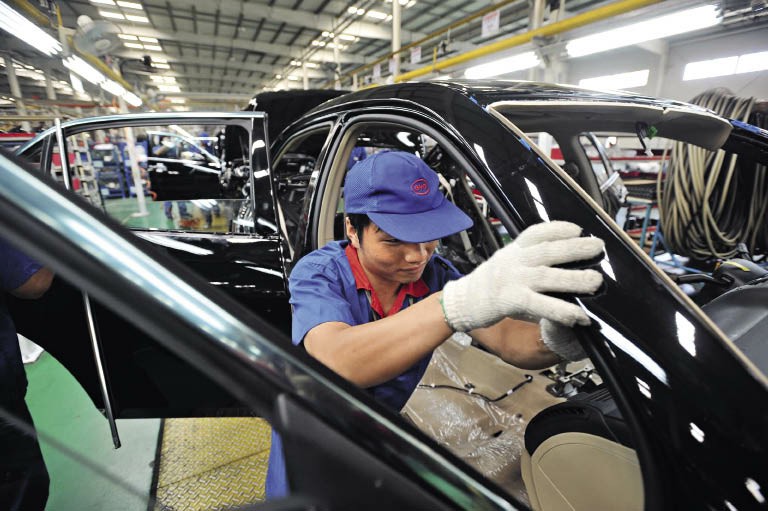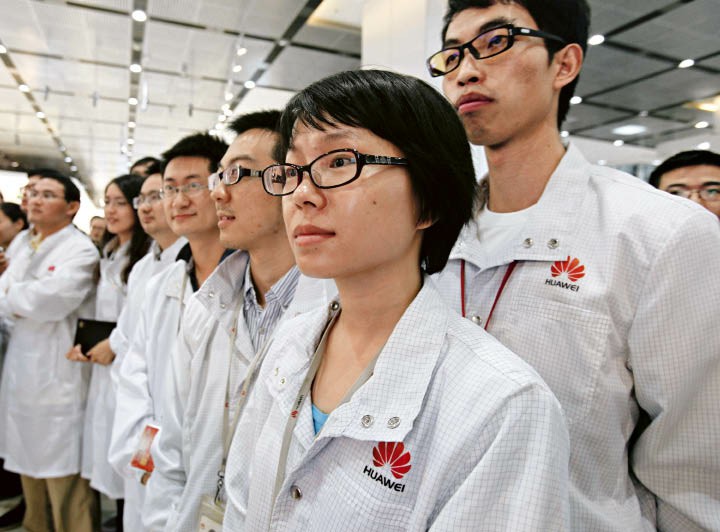
A sculpture named “Perfect time for sailing” at the Civic Center Square of Shenzhen on October 19, 2020.
THE year 2020 marks the 40th anniversary of the establishment of the Shenzhen Special Economic Zone (SEZ). The last four decades saw the transformation of Shenzhen from a fishing village to a metropolis of innovation. On its founding anniversary, the SEZ was empowered to introduce a new round of sweeping reforms; it was granted greater autonomy in deciding matters regarding business environment, technological innovation, market access, and city governance among others. A new development blueprint is rolling out for the city, also marking the start of the country’s new journey of building itself into a modern socialist country.
A Development Miracle
The Shenzhen SEZ has been carrying the arduous task of reform since its inception. Over the past 40 years, it has drafted and implemented as many as 1,000 innovative reform measures to unleash the vitality of the city and build up its global competitiveness in technologies and industries. In 2019, the city’s high-tech sector generated an output of RMB 2.6 trillion with the added value exceeding RMB 920 billion, symbolizing that the sector had emerged as the pillar industry of the city. As a matter of fact, a total of RMB 132.8 billion, or 4.9 percent of its GDP, was invested in research and development, putting it on the top list of the country. In addition to this, the city has seen 17,500 international patents filed, accounting for one third of the national total. Shenzhen has also nurtured some world leading technology firms including Huawei, DJI, and Tencent. Reform and innovation has boosted productivity and enabled Shenzhen to grow by leaps and bounds. The city’s economy expanded exponentially from RMB 270 million in 1980 to RMB 2.7 trillion in 2019, the fifth largest among cities in Asia, with an average annual growth of 20.7 percent.
Opening-up has created vast possibilities for Shenzhen. As a testing ground of China’s opening-up, the city has ridden the tide of globalization and made use of both the domestic and international markets, achieving remarkable economic growth. Its volume of foreign trade jumped from US $18 million in 1980 to $431.5 billion by 2019. The average growth rate was an incredible 26.1 percent. In 2019, foreign trade volume in Shenzhen accounted for 10 percent of the national total, and around 40 percent of the provincial total. At present, more than 290 Fortune Global 500 companies including Airbus, Accenture, Sanofi, Apple, Qualcomm, Nestle, Siemens, and Xiaomi have investments in Shenzhen.

Children and adults having fun at the Happy Valley in Shenzhen.
Experimenting with New Reform
Measures
Chinese President Xi Jinping said at the meeting commemorating the 40th anniversary of the Shenzhen SEZ that China will continue its support to SEZs. Before the meeting, China’s central authorities unveiled an action plan supporting Shenzhen in experimenting measures for building socialism with Chinese characteristics during the next five years. The plan is a roadmap for Shenzhen to spearhead future reform.
China is now at a new development stage as it has shifted its focus from high-speed economic growth to high-quality development. A new development pattern where domestic and international markets boost each other with the domestic market being the mainstay is taking shape. Shenzhen has taken on a totally different look in terms of economic output, market status, development resilience, and governance capacity compared with 40 years ago. It has the foundation and conditions to pilot more bold measures for reform and play a greater role in leading national development. In the meantime, greater mission is accompanied by severe challenges. The world is undergoing tremendous changes unseen in a century. The ravaging COVID-19 pandemic further complicated the global situation. For China, its economy is at a critical juncture of transformation and restructuring. There are short links and weak areas to be shored up, and new issues to be addressed. Advancing reform today is much harder than 40 years ago. In the face of the new situation, Shenzhen should keep abreast of the times, take on greater responsibilities, and push forward reform and opening-up to new heights.
Shenzhen’s further reform should be holistic and across-the-board as was stressed in the action plan released before the commemoration meeting.
The action plan laid out three steps for Shenzhen in piloting measures to build socialism with Chinese characteristics over the 2020-2025 period. In 2020, Shenzhen began reform measures in the sphere of market-based allocation of production factors, business environment optimization, and the utilization of urban space. By 2022, there should be significant institutional achievements that can be replicated and promoted across the nation. By 2025, the objectives of the plan will have been basically completed. To fulfill the targets for each step, Shenzhen should stay aligned with the highest standards both domestically and internationally, and create more replicable practices as it shoulders the responsibilities of playing a leading and exemplary role in national development. This is the paramount mission of Shenzhen in the new era.

The BYD auto production line in Shenzhen.
A Pivot in Dual Circulation
At the commemoration meeting for the establishment of Shenzhen SEZ, Xi noted that China’s new “dual circulation” development pattern is not enclosed, but features open systems. While making the domestic market run smoothly, China values its connectivity with the international market, indicated Xi. What he said charted the course for Shenzhen to fulfil its tasks in the next five years and even for the entire country’s development.
Shenzhen has been at the forefront of China’s reform and opening-up. With a solid industrial foundation, strong manufacturing capabilities, and complete supporting facilities, Shenzhen is capable of withstanding headwinds in economic development and building up a new development pattern. Amid sluggish global trade and investment, Shenzhen bucked the trend and registered increased external trade and foreign investments. From January to August 2020, Shenzhen SEZ logged exports and imports of RMB 1.88 trillion, up two percent year on year, accounting for 9.4 percent of the national total. Its exports amounted to RMB 1.04 trillion during that period, the highest among all Chinese cities. From January to September 2020, the actual use of foreign direct investment in Shenzhen increased nearly eight percent. In the face of global economic volatility, Shenzhen should continue giving full play to its strengths in capital, technology, management, and services, deepen the supply-side structural reform, rise to challenges, and spearhead national economic development.
The Guangdong-Hong Kong-Macao Greater Bay Area is of special significance in China’s national development as it is vital to both the domestic market and China’s role in the international market. As a hub in the greater bay area, Shenzhen has the foundation and strengths in industrial chains, transportation infrastructure, and consumer markets among other areas to lead regional and even national development. A virtuous interaction of the domestic and international markets needs institutional support. Therefore, the alignment of rules and regulations should be promoted, and institutional barriers hindering free flow of production factors should be removed amid efforts to build an integrated market and a world-level modern urban agglomeration in the greater bay area.
In the process, Shenzhen’s economic standing and geographical location require it to play a pivotal role in boosting the “dual circulations” of both the domestic and international markets. Amid global technological revolution and industrial transformation, the SEZ should scale up inputs in technological innovation, particularly in cutting-edge areas including the digital economy and artificial intelligence. It should strengthen its status among the global value chains, overcome the adverse impacts of the COVID-19 pandemic, stabilize its industrial and supply chains, and enhance their security and resilience. Shenzhen should take further moves to keep aligned with the international market and globally-acknowledged rules, thus advancing opening-up to a higher level and fostering the virtuous interaction between the domestic and international markets.

A team of Huawei workers in Shenzhen.
Fostering a Better Business Climate
Foreign investments have given a boost to Shenzhen’s development over the last four decades, the benefits of which have been mutual. China has been following the principle of inclusive development and win-win cooperation in opening-up. With trial measures of further opening the market and improving the law-based business environment, Shenzhen is expected to attract more foreign investors.
Over the last 40 years, Shenzhen has broadened market access for foreign investors. With the new round of pilot reforms, Shenzhen SEZ will lift more restrictions on foreign investment in sectors including energy, telecommunication, public utilities, transportation, and education. In particular, foreign investors will find it easier to do business regarding frontier technologies in Shenzhen. This boosts investors’ confidence against the backdrop of contracting global investment.
The ease of doing business is a major gauge of the composite competitiveness of a country or a city. It has been a focus of Shenzhen in advancing reform in recent years. In the action plan, the central authorities put forth higher standards for Shenzhen’s business environment. To make doing businesses in Shenzhen easier, the SEZ will level the playing field with better government services for businesses in sectors like postal services, telecommunication, and energy, and bring its rules and regulations for commercial affairs, legal services, and international arbitration in line with international laws.
Rule of law is an important factor affecting foreign investors’ choice of investment destinations. Shenzhen has been building rule of law in its economic development over the last 40 years and has achieved notable progress. At the new starting point, it should make further explorations in legislation for emerging sectors like artificial intelligence and big data. Shenzhen will also enforce stricter laws in intellectual property protection, and launch pilot programs in protecting new types of intellectual properties including digital intellectual property.
As Xi noted in the commemoration meeting for the 40th anniversary of Shenzhen SEZ’s founding, Shenzhen was a brand new city built by the Chinese people after the country’s reform and opening-up kicked off in 1978, and it is an embodiment of socialism with Chinese characteristics in practice. At a new historical starting point, Shenzhen is expected to accumulate more experiences in pioneering reform that are to be replicated across the rest of the country.